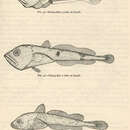Diagnostic Description
provided by FAO species catalogs
Head rather short, 24.4 to 27.4% of standard length. Measurements in relation to head length: upper jaw 50.0 to 54.4%; snout 31.2 to 35.1%; interorbital width 24.0 to 29.8% ; gill rakers long and slender, total number on first arch 16 to 20. First dorsal fin with 1 spine and 10 to 12 rays; second dorsal with 37 to 42 rays; anal fin with 37 to 42 rays; tips of pectoral fins reaching origin of anal fin in young fishes; caudal fin margin truncate in smaller fishes but slightly concave in larger individuals. Scales rather large, 101 to 110 along lateral line. Number of vertebrae 26 to 29 (precaudal) + 27 to 29 (caudal) = 53 to 57 (total). Colour: silvery white.
- Grinols & Tillman, (1970)
- Hunt, (1980)
- Leim Scott , (1966)
- bibliographic citation
- FAO species catalogue. Vol.10. Gadiform Fishes of the world (Order Gadiformes). An Annotated and Illustrated Catalogue of Cods, Hakes, Grenadiers and other Gadiform Fishes Known to Date.Daniel M.Cohen Tadashi Inada Tomio Iwamoto Nadia Scialabba 1990. FAO Fisheries Synopsis. No. 125, Vol.10. Rome, FAO. 1990. 442p.
- author
- Food and Agriculture Organization of the UN
Distribution
provided by FAO species catalogs
Atlantic coast of Canada and USA from Bell Isle Channel (52°N) to the Bahamas (24°N), most common from southern Newfoundland to South Carolina.
- bibliographic citation
- FAO species catalogue. Vol.10. Gadiform Fishes of the world (Order Gadiformes). An Annotated and Illustrated Catalogue of Cods, Hakes, Grenadiers and other Gadiform Fishes Known to Date.Daniel M.Cohen Tadashi Inada Tomio Iwamoto Nadia Scialabba 1990. FAO Fisheries Synopsis. No. 125, Vol.10. Rome, FAO. 1990. 442p.
- author
- Food and Agriculture Organization of the UN
Size
provided by FAO species catalogs
Maximum recorded length 76 cm (2.3 kg weight); common: 37 and 65 cm for males and females respectively.
- bibliographic citation
- FAO species catalogue. Vol.10. Gadiform Fishes of the world (Order Gadiformes). An Annotated and Illustrated Catalogue of Cods, Hakes, Grenadiers and other Gadiform Fishes Known to Date.Daniel M.Cohen Tadashi Inada Tomio Iwamoto Nadia Scialabba 1990. FAO Fisheries Synopsis. No. 125, Vol.10. Rome, FAO. 1990. 442p.
- author
- Food and Agriculture Organization of the UN
Brief Summary
provided by FAO species catalogs
Abundant on the continental shelfin depths from 55 m to 300 m on sandy grounds but can be found up to 914 m depth; sometimes strays into shallower waters.Females grow faster than males. Intensive spawning occurs from June to July on the southeastern and southern slopes of Georges Bank, from June to September on the Scotian shelf, and from August to September off Sable Island Bank. Spawning appears to be strongly influenced by water temperature, and annual variations occur both in the peak and the range of the spawning period, which may influence considerably the growth of juveniles. This hake exhibits a seasonal onshore-offshore migration: spawning adults and feeding juveniles move inshore during spring and, when winter cooling occurs on the shelf, they migrate to warmer waters on the continental edge and slope.Growth is rapid; maximum age is about 12 years.A voracious predator with cannibalistic habits: individuals over 40 cm total length prey on fishes such as gadoids and herring, while smaller ones feed on crustaceans, i.e. euphausiids and pandalids.
- bibliographic citation
- FAO species catalogue. Vol.10. Gadiform Fishes of the world (Order Gadiformes). An Annotated and Illustrated Catalogue of Cods, Hakes, Grenadiers and other Gadiform Fishes Known to Date.Daniel M.Cohen Tadashi Inada Tomio Iwamoto Nadia Scialabba 1990. FAO Fisheries Synopsis. No. 125, Vol.10. Rome, FAO. 1990. 442p.
- author
- Food and Agriculture Organization of the UN
Benefits
provided by FAO species catalogs
The total catch reported to FAO in 1987 amounted to 77 920 t (434 937 t in 1973); of which 41 329 were taken by the USSR (an important constituents of their fisheries since 1962), 20 219 t by Cuba, and 19 by the USA. The main fishery for this hake takes place off the coast of Nova Scotia, in the Gulf of Maine and on the Georges Bank in depths up to 220 m. The most common fishing technique is "demersal bottom trawling". The estimated catch potential of this hake in the Northwest Atlantic is estimated to be 350 000 to 500 000 t. The flesh is firm-textured and very tasty. Marketed filleted, frozen, hot-smoked and boiled, and fried.The total catch reported for this species to FAO for 1999 was 27 567 t. The countries with the largest catches were USA (14 039 t) and Canada (9 676 t).
- bibliographic citation
- FAO species catalogue. Vol.10. Gadiform Fishes of the world (Order Gadiformes). An Annotated and Illustrated Catalogue of Cods, Hakes, Grenadiers and other Gadiform Fishes Known to Date.Daniel M.Cohen Tadashi Inada Tomio Iwamoto Nadia Scialabba 1990. FAO Fisheries Synopsis. No. 125, Vol.10. Rome, FAO. 1990. 442p.
- author
- Food and Agriculture Organization of the UN

